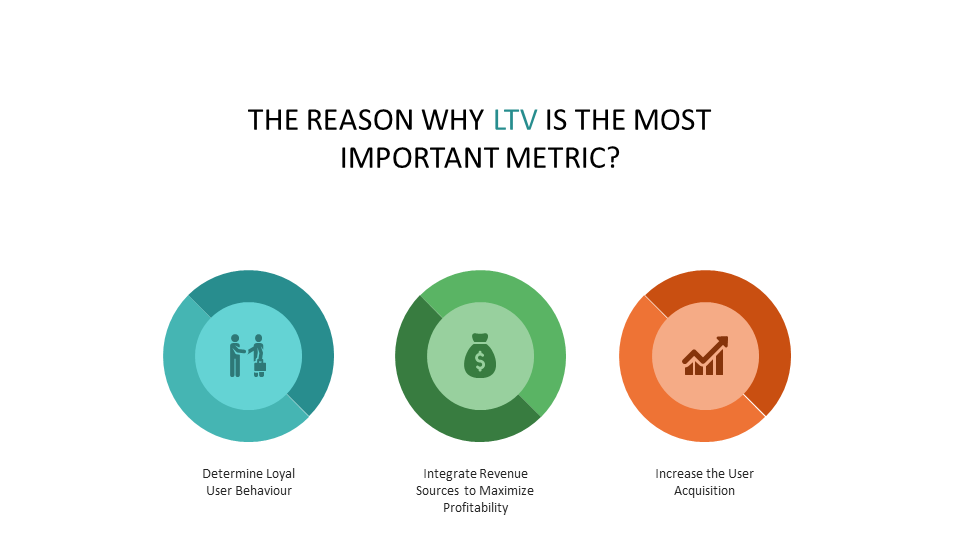1. Introduction
Lifetime Value is an appraisal of the monetary value generated through the user’s engagement within the game environment, such as in-app purchases and in-app ads. Monetization and retention are important components of its measurement. Monetization is a user’s contribution to the overall game revenue. It is possible to use different metrics while calculating monetization (ARPDAU, ARPU, ARPWAU, ARPMAU).

On the other hand, retention is a concept of understanding user engagement according to their behavior. How much time a user plays the game in a day, and how many times do they launch the game on a basis? etc. LTV is calculated by the total days a player spends multiplied by revenue per day. Tracking this metric is essential to understanding your game’s market value. By doing that, marketers can rearrange their marketing budget according to their lifetime value and make wiser decisions to increase the success rate of the game.
2. The Reason Why LTV is the Most Important Metric?

LTV is useful for setting marketing budgets by predicting how much consumers are willing to spend on the game.
To estimate the game’s profitability, lifetime value is essential for game developers. It enables them to optimize revenue sources for maximum profit while determining the money spent on user acquisition. Furthermore, the developers can observe their loyal users’ behavior. Testing the effects of content updates and analyzing the new game’s potential while in beta version is also possible with lifetime value evaluation.
On the other hand, lifetime value has some complexions due to the multiple measurement systems of the game. For this reason, some developers do not prefer to calculate lifetime value. However, it is essential to maximize the revenue of the game.
3. How to Calculate the Lifetime Value?

*ARPDAU: ARPDAU is a metric measuring the average revenue per daily active user, and it is an essential metric to estimate whether the monetization strategy works or not. ARPDAU is calculated by dividing daily income by the daily active users. It is essential to make informed decisions since it gives an understanding of user engagement and the mean of user payments.

4. Simplify the Onboarding Experience
Onboarding processes are essential when users download and launch your game since they look for a starting experience. Testing different onboarding processes displays which one works best for you. Optimizing the demo experience in terms of its duration and design is just one area where AppNava can assist in improving your onboarding experience. Tutorial, menu design, and integration are further essential elements that may contribute to a more pleasant onboarding process.
5. Experiment with Game Difficulty
Keeping your players engaged should be the next step after launching your game. The key to success in the business is making it both challenging and entertaining. The game should be on the right fun-challenge bliss point which can be done by diverted cohort groups. For instance, AppNava detects each players’ behavior and segments them into distinct difficulty levels while they play the game. Thus, the players get motivated to play the game as each player faces customized game reactions. For example, in an online football game, an AI bot confronts a challenging user with a gamer who loves to be challenged.
6. Create Periodical In-Game Events
According to some research, enriching your game with different in-game events on seasons, and holidays has a positive impact on revenue and retention. Consequently, this also increases the mobile game’s user LTVs. For instance, organizing special competitions, adding new skins, giving discounts, and handing out exclusive rewards can be very helpful.
7. Segment your Players
Segmenting the players is one of the crucial steps to improve LTV. After a while, it is possible to understand the coherence between the characteristics and in-game behavior.
The players can be segmented by their:
- Spending Habits (high vs. low spenders);
High spenders are actually called mobile game whales, and they spend big amounts on a game. Although they make up 2% of the population, they dominate a mobile game’s market share with their purchases.
- Consuming Habits (snacking vs. feasting);
Snacking is a short period of interaction that is the most profitable for companies and the most convenient for users since this idea is about keeping users engaged and motivated. If a user plays the game with a feasting habit, it won’t be healthy for both users and developers because sources would be exhausted immediately.
- Behavior over time (e.g., after an update)
- Locations
- In-game actions
8. Rearrange Players
Sending out push notifications can be very helpful to re-engage users. In order to ensure maximum personalization with valuable content, the process should be done by considering the behavioral data of each player. For example providing time-limited offers, important game updates, special deals for loyal customers can be the ways to rearrange players. However, keep in mind that these push notifications should not annoy the players which can make them decide to uninstall the game. There should be a fine line between the two.
9. Encourage Social Sharing
Integrating a share button after completing a chapter, level, etc. in the game enables players to contribute to the awareness and increase the popularity of the game. Additionally, establishing a social gaming community via social media platforms also might assist in expanding the audience. Furthermore, users can be encouraged to share their experiences, challenges, and goals within this strategy.
10. Conclusion
LTV is crucial for understanding the profit margin that comes from in-app purchases, ads and the time spent on the game, and many dynamics. Using data-driven insights into player behavior can pose an opportunity for improving the underlying metrics. LTV, at its core, is not a static metric.
When a user’s behavior is predicted by the game, it is possible to change the user habits in a good direction by limiting their gameplay period daily, instant rewarding in exchange for mission completion, unlocking new skin, skills, the item, which significantly increases the revenue.
Providing the right incentives can lead to an improvement. AppNava’s ML-powered models aim to provide the maximum amount of insights for you to take the right steps to enhance your players' LTV values. At AppNava, we help mobile game developers to understand their player’s value and increase their games’ lifetime value by customizing each player’s experience and behavior dynamics based on their decision-making process by increasing the users’ playtime.
Special thanks to Selin Demirler, Ceren Ademoğlu & Tizianpeer for their help creating the content.



